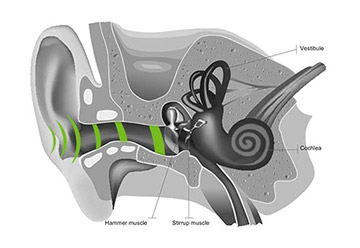
Sound starts its journey when captured by your outer ears, the two formations on either side of your head, travelling in air through several structures within the ear, then translated by your nervous system and your brain for use as information to live in the world.
In those with normal hearing, sound waves enter the outer ear, travel through the middle ear to the ossicles, three small bones, which transmit sound vibrations to the cochlea vestibule nerve in the inner ear.
The cochlea vestibule’s job is to convert these sounds into electrical impulses and send them along the auditory nerve to the brain.
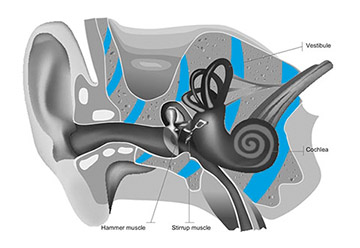
There is another fascinating way our body processes sound. Sound waves transmitted through the bones in our heads!
When our bones vibrate, the sound goes directly to the cochlea vestibule nerve in the inner ear. This sound transmission directly through our bones is similar to traveling through the eardrum and middle ear. This vibration also creates nerve impulses and connects sounds to our brains. This Process is bone conduction!
In Forbrain® the amplified bone conduction and natural air conduction work with an individual’s voice to process information more clearly and understand communications better.
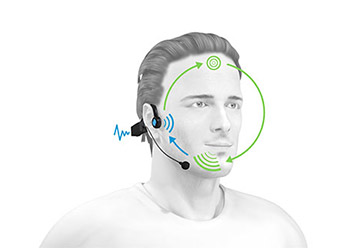
This is the natural process by which every individual perceives, analyzes assimilates and continuously adjusts the information individually received and produced through sound.
To function properly, this audio-vocal loop draws on the abilities of auditory discrimination, phonological awareness and integration of rhythm that each person activates effortlessly. These skills are natural to human function and go far beyond speech. They are necessary in all learning processes.
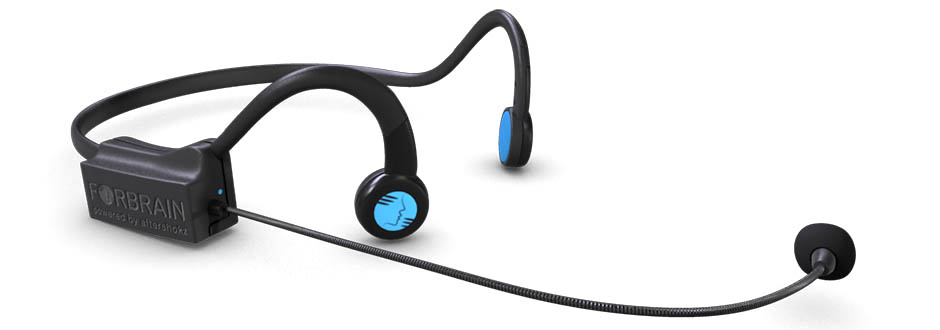
FORBRAIN® headphones leverage high frequency vibration to help the user create and process sound. The patented electronic dynamic filter blocks out environmental noise—isolating and amplifying the user’s voice, giving the nervous system a solid sensory workout. It also enhances long vowels and other sounds critical to the construction of language. The resulting sound is delivered through the bones and bone conduction, not the ears or air conduction, to the nervous system and brain.
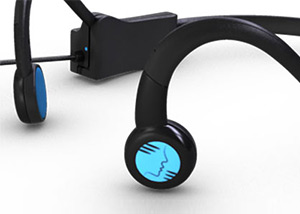
“We listen to ourselves through our bones”. When we emit a sound, our vocal cords vibrate. This vibration transmitted primarily via bone conduction and secondarily by air conduction through the eardrum. That’s why, when we cover our ears, we can hear our own voices without any difficulty. This bone transmission is fundamental because it prevents hearing loss and safeguards sound information against loss that occurs with air conduction and environmental noise.
The purpose of Forbrain® is to amplify sound transmission through bone conduction. A user improves the perception of his own voice due to bone conduction headphones equipped with a high sensitivity microphone. He can easily analyze and assimilate the information emitted. By placing himself in an optimal position of self- listening, the user is more attentive to what he is saying.
As Forbrain® sits on the temples leaving the ears unblocked, it allows the user to continue to perceive surrounding sounds normally. An individual can not only concentrate on his own voice without cutting out external sounds and but also peruse to efficiently focus on relevant sounds. At the same time and while using Forbrain®, he can listen to and communicate normally with other people (parents, teachers, therapists, coaches, etc.).
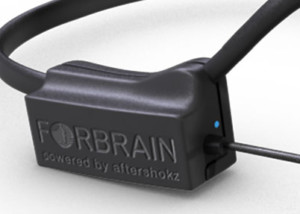
While bone conduction facilitates good self-listening, the message emitted by the voice provides a sound of good quality! Forbrain® is equipped with a dynamic filter that reacts to the intensity of the voice.
The user hears her own voice filtered with alternating contrast. This shifting of sound or alternation will occur mainly during the beginning of speaking words and long vowels, the “clear sounds” that are strongly involved in the construction of language.
By hearing and choosing this new perception of sounds, the user instantly and unconsciously significantly improves the quality and rhythm of her voice. In addition, this alternating filter design is to amplify high frequencies and simultaneously diminish low frequencies. As a result, this dynamic filter accentuates the transmission of high-frequency harmonics which play a fundamental role in cortical stimulation and increased energy.
The dynamic filter improves not only the user’s hearing, but also the user’s entire vestibular system, managing motion, core stability, motor planning, balance, and spatial orientation. The result? Clearer vocal quality and rhythm. Improved listening. Greater focus and concentration. A better ability to “fit in,” and higher self-esteem.
Forbrain® improves activities that involve additional performance areas such as reading (better comprehension) or going to the gym (more productive workouts). It reduces your sensitivity to noise, makes yourself get in touch more easily with your own voice and thus, increases self-confidence. Your body receives better quality sensory information with daily use of Forbrain®.
Through the use of Forbrain®’s dynamic filter, your sensory system is trained to more efficiently integrate sounds with other sensory input resulting in a number of major improvements. Your tone of voice becomes clearer and more distinct. Forbrain® helps improve not only the quality of your voice but also your ability to listen carefully and communicate. These and other changes have a positive impact at work, home and school. There are a number of Forbrain® applications that bring ease of living and enjoyment to all you do in your day.

With greater clarity of sound reception and more efficient processing, comprehension of the written word is greatly improved. This new found ease of reading stimulates your brain and motivates you to read more. Speaking and reading aloud with the Forbrain® microphone and dynamic filter strengthens your auditory perception, energizing and motivating you. This increased processing ability also stimulates verbal fluency and written expression.

Repetitive use of your voice exercises and trains your brain. These repetitive exercises tap into areas of the Cochlea, which connect through the auditory pathways to your verbal and short-term memory. When you speak or read aloud using the Forbrain® system, your own voice activates these auditory pathways in your brain enabling you to access memory more easily. Daily use of Forbrain® supports improved memory.

Problems with attention often occur because of difficulties with sound perception. 80% of sensory information comes via the ear, and this determines the brain’s overall level of alertness and attention.Through heightened bone conduction and the use of the dynamic filter, Forbrain® enhances sound procesing and your attention. This improves your ability to eliminate distractions, a major cause of inefficiency. Sustained attention allows for clearer thinking, greater productivity and improved memory.

Does your mind race or work non-stop? Do you feel that you are having scattered thoughts and it is hard to relax? Through use of the fine-tuned, high quality Forbrain® microphone, improved voice clarity and better auditory perception helps you stay on task and follow-through to complete activities. Consistent use of Forbrain® improves focus so you can concentrate better throughout the day and follow through on tasks and actions.

Bone conduction provides the clarity and sensory integration that improves pronunciation skills. This enhanced awareness and perception of speech is a prerequisite to phonological and linguistic awareness. Phonological awareness, the ability to interpret the foundational sounds of language, is key for clear speech production. Reading development also strongly depends on the emergence of phonological awareness and the ability to accurately relate sounds to words. Bone conduction is critical to the development of the phonological loop, which also plays a role in the storage and retrieval of verbal information. Forbrain® can thus enhance not only auditory verbal memory but inner speech and verbal fluency, too.

By enhancing sensory perception, focus and clarity, and minimizing distractions, Forbrain can calm the nervous system. Forbrain® works directly on your nervous system by focusing attention on your voice and reducing the sound and other sensory clutter in your brain. This settles the nervous system and improves confidence, motivating you to take action and succeed.

by Carles Escera, PhD, Professor
Director of Institute for Brain, Cognition and Behavior (IR3C)
Department of Psychiatry and Clinical Psychobiology University of Barcelona (info)
(…)
Forbrain® is a user-friendly device that uses a bone conductor and a series of dynamic filters to provide feedback to the user that it is thought to improve perception by optimizing all the components of the audio-vocal loop. It is considered a product that can improve speech, fluency, memory, focus, coordination and many other sensory functions, resulting in several adjustments in the psychological/cognitive/emotional domain.
The use of a bone conductor by Forbrain® extends the possibilities of stimulus manipulation and presentation in an unprecedented way, resulting in new ways to enrich the acoustic environment. Through bone conduction (bone vibration), the travelling waveform of a sound reaches the inner ear, induces a travelling wave in the basilar membrane and stimulates the cochlea by the same mechanisms as normal air conduction (Stenfelt et al., 2003). This way, the cochlea, its basilar membrane and the encoding of the incoming sound signal into a neural pulse, creates a bottleneck through which both air conducted and bone conducted sounds converge on their way to the central auditory system (Stenfelt et al., 2003; 2005).
If the amplitude and phase of a particular sound are appropriately adjusted, its cochlear signal need to cancelled out. Therefore, through the dynamic filter used in Forbrain®, unexpected and random changes in the bone conduction signal introduced that may eventually cancel out or distort the air conduction signal to the very same sounds, resulting in unexpected, rare and potentially surprising changes in the auditory signal.
With regard to Forbrain® and as a critical factor to be taken into consideration that the cochlea, its basilar membrane and the encoding of the incoming sound signal into a neural pulse is a bottleneck through which both air conducted and bone conducted sounds converge in their way through the central auditory system (Stenfelt et al., 2003; 2005). Hence, if the amplitude and phase of a particular sound are appropriately adjusted, its cochlear signal should be cancelled out. This was already anecdotally observed by von Békésy for a 0.4 kHz tone in humans, and subsequently replicated in animals and humans for frequency ranges of 0.1 to 15 kHz (Wever and Lawrence, 1954; Khanna et al., 1976).
This is important because, through the dynamic filter implemented in Forbrain®, unforeseen and random changes in the bone conduction signal may result that may eventually cancel out, or at least modify substantially with the air conduction signal to the very same sounds (i.e., the one uttered by the user that reaches the air canal and the emitted by the bone canal after modification by the Forbrain® filters resulting in unexpected, rare and potentially surprising changes in the auditory signal that it is finally transduced at the cochlea and conveyed to the central auditory system.
Forbrain® may indeed induce plastic changes in the central nervous system by at least two independent but related neural mechanisms: 1) by challenging the audio-vocal loop through the modified speech signal leading to an enriched acoustic environment yielding auditory plasticity, and 2) by forcing a series of executive mechanisms of attention control to cope with the involuntary attention signals triggered by the mismatching speech inputs. The final outcome of all these processes may be the reinforcement of the executive mechanisms of attentional control, resulting in better concentration, stronger resistance to distracters, improvements in working memory capacity and the feeling of being more focused.
Compared to many other training and rehabilitation methods for communicative skills, language improvement, and cognitive enhancement, Forbrain® has the advantage that although active –it requires the user to speak aloud and to follow a certain regime of exercises– it imposes very few demands on the user. Indeed, whereas other methods require the attainment of a certain level of performance on a range of exercises of increasing difficulty over several weeks, Forbrain® exercises are to enhance the user’s motivation, commitment and willingness to follow the training. This is obviously a strong competitive asset.
Critically, if the “natural” input of the expected voice via the air canal is pass by providing “unnatural” (the “extra” bone conduction feedback) and therefore “unexpected” input through the bone canal, the sensory predictions triggered by the efferent copy ar resulting in necessary adjustments to the model of the sensory expectation. This template violation by an unexpected input necessarily results in an attentional challenge, as the auditory system identifies the incoming signal as “deviant”, “rare” or “unexpected”, resulting in an involuntary attention switch (Escera et al., 1998).
As a matter of fact, a large body of evidence has indicated that novel or unexpected auditory stimuli trigger an involuntary attention switch toward the incoming stimulus resulting in behavioral distraction of the ongoing primary task and a concomitant adjustment of brain activity in the underlying neural network (see reviews in Escera et al., 2000; Escera and Corral, 2007). Thus, under conditions of auditory feedback through bone conduction, one might expect to submit the auditory system to a regime of constant challenge through a novel or unexpected stimuli, increasing attentional demands. Furthermore, the implementation of the gating filter introduces frequency and temporal manipulations on the emitted voice so that it further deviates the incoming signal from its efferent copy, increasing the attentional challenge driven by Forbrain® even more.
Forbrain’s® use of the dynamic filters alters the user’s speech signal that is then sent back via a bone conductor and mismatches the corollary discharge (efferent copy) of the planned sounds. This forces online fine-grained adjustments in the audio-vocal loop, leading to auditory plasticity. The vocal (motor) system sends an efferent copy or corollary discharge of the sound it aims at producing, so that the encoding of the auditory input resulting from the self-produced sounds is attenuated in the auditory system (Aliu et al., 2008; see Wolpert et al., 1995; Crapse and Sommer, 2008; Scott, 2013).
It is well established that the auditory cortex can undergo plastic changes in response to behaviorally relevant sounds (Fritz et al., 2005; Nelken, 2009), such as those that are ready to reward or punishment in animal experiments. What seems to be critical for inducing these plastic changes is the behavioral importance of the stimulus. A paramount example of this property of the auditory system is work in the brains of musicians, who show major functional and anatomical differences compared to non-musicians (Zatorre, 2013).
Yet, auditory plasticity is not only seen in active conditions. For example, Eggermont and colleagues demonstrated in cats that passive long-term exposure to a spectrally enhanced acoustic environment caused a massive reorganization of the tonotopic map in the auditory cortex (Noreña et al., 2006; Pienkowski and Eggermont, 2012). Also, brain plasticity induced by passive music listening (one hour daily during two months, of self-selected materials) observed in a study of patients recovering from a stroke (Särkämo et al., 2008). These patients showed enhanced recovery in verbal memory, focused attention, and several mood measurements, that maintained after 6 months of the treatment.
The cerebral network for language includes Broca’s area in the frontal lobe of the left hemisphere, and its comprehension counterpart, located in the Wernicke’s area in the posterior bank of the superior temporal lobe. There is, however, a particular auditory-related area located in the posterior part of the Planum Temporale of the left hemisphere that is also involved in speech production, the so-called Spt area (Hickok et al., 2000, 2003). Spt activated during the passive perception of speech and during covert (subvocal) speech articulation (Buschbaum et al, 2001, 2005). It is highly correlated with the pars opercularis (Buschbaum et al., 2005) –an anatomical region subserving part of Broca’s area — with which it is densely interconnected through white matter tracts (Hickok et al., 2011).
Hence, by being situated in the middle of a network of auditory (superior temporal sulcus) and motor (pars opercularis) areas, the Spt has been considered as the hub of sensori-motor integration for speech and related vocal-tract functions (Hickok et al., 2010), being implicated in auditory feedback control of speech production. It has been proposed that the Spt region works as a control mechanism for dynamically altering the signals of the planned speech as it is being produced (Hickok et al., 2010).
This is very relevant for Forbrain® because the sensory feedback provided by the bone conductor and the dynamic filters do really violate the internal predictions, leading necessarily to online readjustments and retuning of the internal model for speech. For example, a study showed that persistent developmental stutterers display a deficient representation of the sounds of their native language (phonemes), in the presence of preserved acoustic features representation, as measured in passive conditions (Corbera et al., 2005). Moreover, these deficient phoneme representations correlated with the severity of the stuttering, supporting the theoretical model described above.
An important implication of the model in general and in particular regarding Forbrain® is that using one’s own voice is sufficient to generate corrective signals for motor speech acts, as hearing other speakers’ voices is sufficient to learn and tune new motor speech patterns. Hence, one can expect that motor-speech networks in the frontal cortex activated during passive speech listening, at the same time that a profound system recalibration is taken place online at a very subtle level during normal speech production. Now, if the expected incoming signals from one’s own voice are profoundly violated, as occurs with Forbrain®, dramatic plastic changes are expected in the audio-vocal loop.
The unexpected violations of the template predictions of self-emitted sounds trigger a cascade of involuntary attention processes reorienting attention back to the primary task (e.g., the ongoing message) all of which occurs on a sub-second scale. Indeed, a consequence of the mechanisms explained above is that the sensory predictions triggered by the efferent copy of the speech violated by the manipulated bone conduction input, resulting in necessary adjustments to the model of the sensory expectation. This template violation by an unexpected input results in an attentional challenge, as the auditory system identifies the incoming signal as “disruptive” yielding an involuntary attention switch (Escera et al., 1998).
A large body of evidence has indicated that novel or unexpected auditory stimuli trigger an involuntary attention switch toward the incoming stimulus resulting in behavioral distraction of the ongoing primary task and a concomitant adjustment of brain activity in the underlying neural network (see reviews in Escera et al., 2000; Escera and Corral, 2007). The activation of this neural network tracked by the recording of its neural signature at the scalp, that is to say, by extracting the corresponding event-related brain potentials from the ongoing EEG. A series of waveforms already identified that conform the so-called distraction potential (DP; see Figure 1), and that reflect three successive stages in the involuntary attention chain: the mismatch negativity (MMN) reflecting detection of the disparity (Escera et al., 1998); the novelty-P3, reflecting the effective orienting of attention towards the eliciting sound (Escera et al., 1998), and reorienting negativity (RON) (Schröger and Wolff, 1998; Escera et al., 2001).
Also, the DP can reveal the interactions between top-down and bottom-up forms of attention, such as during working memory load (San Miguel et al., 2008) and emotional challenge (Domínguez-Borràs et al., 2009). As discussed above, it is very likely that by the nature of the manipulations it introduces to the voice of users, Forbrain® induces a remarkable challenge to this cerebral network for involuntary attention control, and the recording of these involuntary attention-related potentials provides an unprecedented framework to validate its principles of action.
Moreover, the auditory system can also cope with distracters, easily reorienting attention back to task performance after a transitory attention switch (Escera et al., 2001; Schröger and Wolff, 1998; see Escera and Corral, 2007). The final outcome of all these back and forth processes of orienting and reorienting of attention might be a general improvement in attention control capabilities, allowing better protection against distracters and better focused behavior.
 Figure 1. The distraction potential (DP). (left) Event-related brain potentials elicited to standard, deviant, and novel trials during visual task performance while ignoring
the auditory stimulation. (right) Subtraction waveforms (distracting, i.e., deviant and novel, minus standard trials) revealing DP.
The DP appears as a three-phasic waveform disclosing the contribution of MMN, N1-enhancement, P3a/novelty-P3,
and RON. Adapted from Escera and Corral (2007).
Figure 1. The distraction potential (DP). (left) Event-related brain potentials elicited to standard, deviant, and novel trials during visual task performance while ignoring
the auditory stimulation. (right) Subtraction waveforms (distracting, i.e., deviant and novel, minus standard trials) revealing DP.
The DP appears as a three-phasic waveform disclosing the contribution of MMN, N1-enhancement, P3a/novelty-P3,
and RON. Adapted from Escera and Corral (2007).While auditory and speech perception comes naturally for most people, even when carried out in normal environments, such as in busy city streets, cafeterias, concurred social events and even at the classroom, the auditory system has to implement what is known as successful “speech-in-noise perception.”
Children, especially those with learning disabilities and older adults are particularly vulnerable to the effects of noise on speech perception (Bradlow et al., 2003; Ziegler et al., 2005; Kim et al., 2006). These difficulties may arise even in the presence of normal hearing audiometry, suggesting that the underlying deficits arise from central auditory deficient mechanisms (Anderson and Kraus, 2010). Consequently, it has been proposed that some learning disabilities in children may result in part from a noise exclusion deficit, which would manifest in the presence of noisy but not in quiet situations (Sperling et al., 2005; Ziegler et al., 2009).
Speech-in-noise perception is a complex task involving the interplay between sensory and cognitive processes. In order to identify the target sound of a speaker from the background noise, the auditory system first needs to form an auditory object of what it is hearing based on spectro-temporal cues. For example, the speaker’s voice is identified by an auditory grouping of the critical acoustic features, such as the fundamental frequency (F0) and the second harmonic of the stimulus (H2) defining the vocal pitch (Anderson and Kraus, 2010).
Several studies have demonstrated that the auditory brainstem response recorded from the human scalp known as the Frequency Following Response (FFR), considered as the biological signature of sound encoding in the auditory brainstem, is delayed and attenuated when obtained to stimuli presented in background noise conditions (Cunningham et al., 2001; Anderson and Kraus, 2010). Moreover, several recent studies have shown that different training programs can help improve speech-in-noise perception by enhancing the encoding of the speech-relevant features in the auditory brainstem (Anderson and Kraus, 2013; Kraus, 2012). Here, Forbrain® appears to be a very powerful way of inducing the necessary auditory plastic changes to improve speech-in-noise perception.
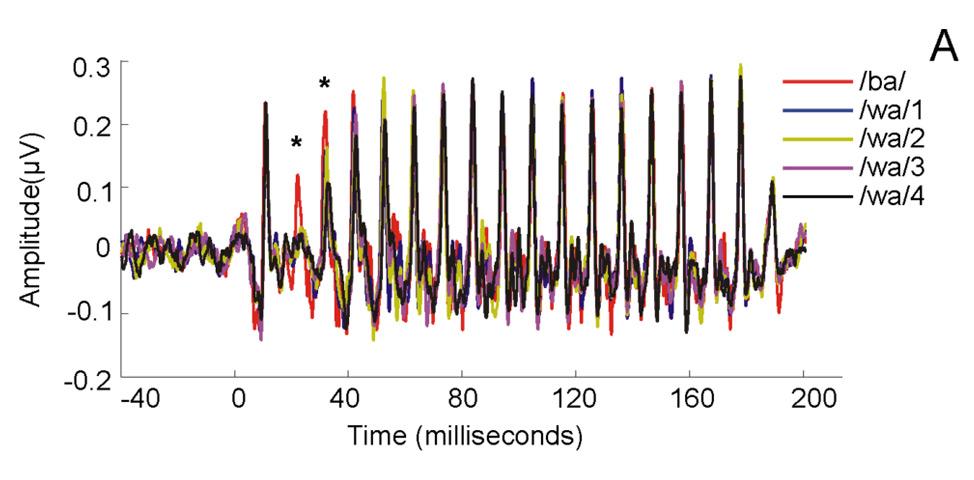
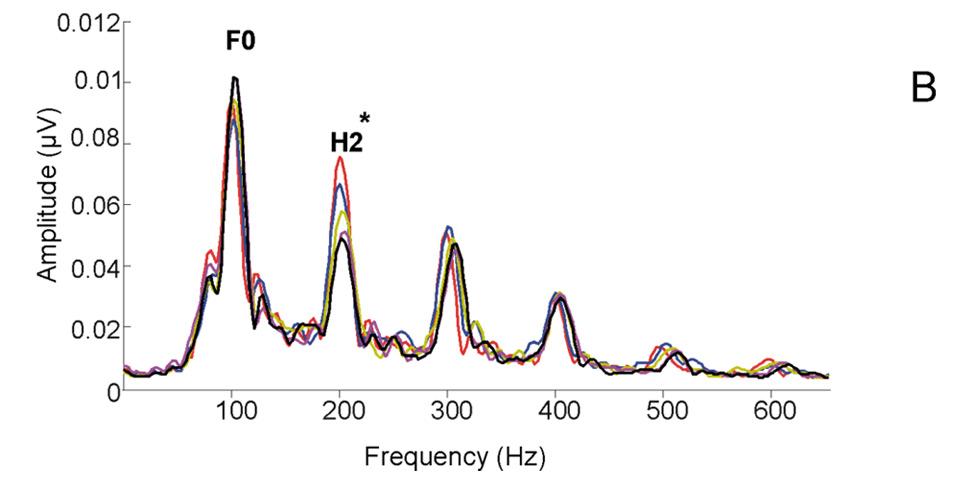
Figure 1. The Frequency Following Response (FFR) (A) and its corresponding spectra components (B) for the /ba/, /wa/1, /wa/2, /wa/3, /wa/4 stimuli presented with equal probability in
the same stimulus sequence. A) Notice the significant enhancement of the response amplitude in two latency windows (18-22 ms and 27-31 ms) over the temporal transition of F1 and F2 that was observed for the /ba/ syllable in comparison to the /wa/1 syllable (´*´, p<0.05). B) Remarkably, the amplitudes of the H2 harmonic followed the increase of the formant transition durations, so it can be considered as the biological marker of the encoding of this sound feature in the human auditory brainstem. Adapted from Slabu et al. (2012).
1. A scientific single case study on speech, auditory processing and attentional strengthening with Forbrain.
Dr. Carles Escera, Professor – Institute for Brain, Cognition and Behavior (IR3C) and Department of Psychiatry and Clinical Psychobiology University of Barcelona – 2014
2. Forbrain’s effect on the reading process.
Beatriz Aguilar Guerrero, Language teacher – UNIR (Universidad Internacional de La Rioja – Universidad en Internet) – 2015
3. Forbrain®’s effects on the reading speed and comprehension ability.
A study conducted at the Mediterrani de La Ampolla School (Tarragona, Spain) – 2015
1. Impact of Speech treatment and Auditory Feedback training with Forbrain for Children with Speech Sound Disorder.
Dr. Alycia Cummings, Assistant Professor, CCC-SLP – University of North Dakota, Communication Sciences and Disorders – 2016
2. Determine if modifications in auditory amplitude using Forbrain can improve reading ability.
Dr. Scott Decker, Assistant Professor – University of South Carolina, Department of Psychology – 2015
3. Phasic boosting of attentional capabilities with a Forbrain® session.
Dr. Carles Escera, Professor – Institute for Brain, Cognition and Behavior (IR3C) and Department of Psychiatry and Clinical Psychobiology University of Barcelona – 2015
4. A single-case study of phasic boosting of attentional capabilities with Forbrain® on Stuttering.
Dr. Carles Escera, Professor – Institute for Brain, Cognition and Behavior (IR3C) and Department of Psychiatry and Clinical Psychobiology University of Barcelona – 2015

A scientific single case study on speech, auditory processing
and attentional strengthening with Forbrain®
Forbrain® is a user-friendly device that uses bone conduction and a series of dynamic filters to give the user feedback of his/her own voice in a way that is proposed to optimize all components of the audio-vocal loop thus improving auditory perception. It has been suggested that the device can enhance speech, fluency, memory, focus, coordination and many other sensory functions, resulting in several improvements in the psychological (cognitive) / emotional domain.
The present single-case study is the first attempt to test the hypothesis that Forbrain® indeed induces plastic changes in the brain by at least two independent but related neural mechanisms:
The final outcome of all these processes may be the reinforcement of the executive mechanisms of attentional control, resulting in better concentration, stronger resistance to distracters, improvements in working memory capacity and the feeling of being more focused.
In this proof-of-concept research, an individual case study (a 21-year old healthy female) carried out to determine what mechanisms and changes detected following five fifteen minute sessions of Forbrain® use on consecutive days plus a follow-up day three days later. Specifically, the research design was intented to look at the purported neural mechanism that challenged the audio-vocal loop through the modified speech signal leading to an enriched acoustic environment resulting in auditory plasticity. In addition, it researched whether focus could be improved by forcing the executive mechanisms of attentional control to cope with involuntary attention signals triggered by mismatching speech inputs.
Measurements taken prior to use, during use and after use and included metrics on voice quality, emotional arousal as measured by skin conductance and heart rate, and attention which looked, among other things, the neurological response to distraction (ATT test).
The auditory discrimination of speech (AUD test measured by a test that looked at the acoustic (fundamental frequency and intensity) and phonological (vowel identity and duration) changes.
The procedure was as follows:
This very same schedule took place on five consecutive days, featuring a total of 75 minutes of Forbrain® use.
The present single-case study designed to scientifically test whether the use of Forbrain® had any cognitive enhancement effects. To test for such effects, a sophisticated design implemented that recorded behavioral, psychophysiological and brain responses before, during and after Forbrain® was used for 15 minutes on five consecutive days, plus a follow-up day. The data analyzed by means of quantitative statistical methods suited for single-case studies (Manolov et al., 2014; Shadish et al., 2014a; Shadish et al., 2014b), and the results obtained revealed significant effects on all three levels of analysis: behavioral (voice quality), psychophysiological (emotional arousal), and neuronal (activation of the cerebral network of attention control). Specifically, the results summarized as follows:
The research is, of course, subject to all the limitations of single case design and has limited generalizability. However, as a first step in researching the effects of limited use of Forbrain, the results suggest that there is a real basis for the claims that Forbrain can improve voice quality and the executive attentional mechanisms and memory.
The results suggest that Forbrain® could be helpful in improving focus in those who have attention disorders such as ADHD, and those who have difficulties with speech production and auditory processing. Moreover, any improvement in attention, such as demonstrated in this study, could have benefits to everyone on memory, focus, and fluency.


Scalp pictures illustrate the temporal series of all 48 measurements of the N1-enhancement and the late novelty-P3, split by recording days and pre- and post treatment series with Forbrain. These measures show significant attenuation of distraction.

Further research should be undertaken to fully understand the scope and the pervasiveness of Forbrain® effects.
The full report of this research will be published in a Scientific Review. We will publish it on our website soon.
Download the summary report here

Forbrain®’s effect on the reading process
SUMMARY REPORT
Master Degree thesis by Beatriz Aguilar Guerrero
This experimental study forms part of the thesis written by Beatriz Aguilar Guerrero at the UNIR for her Master’s Degree in Neuropsychology and Education. Its aim is to study Forbrain’s working mechanisms and quantify the possible improvements to the reading processes of children in the first years of primary school. The study was carried out using experimental and control groups as well as pre- and post-use evaluations. The children used Forbrain daily for 10-minute sessions over 10 days.
During this time, the children read stories and texts adapted to their reading level. To quantify the results, the PROLEC-r battery was used in its simplified version. This made it possible to obtain remarkable results both in capability and execution in the following variables: number of letters, pseudo-words, grammatical structures, and reading comprehension. The statistical analysis of the resulting data showed excellent results. The students using Forbrain showed significant improvement in all tests when compared to the control group.
Based on these results, it can be concluded that Forbrain improves the cognitive capacities involved in the reading process owing to the modification and improvement of the plasticity on the brain structures involved in the reading process. This exercise with Forbrain allowed the students to improve their ability to read and to decode each sound, word, pseudo-word and syntactic structure which is at the heart of the reading process. The students also improved all lexical, syntactic and semantic processes fundamental for their learning abilities. The improvement experienced by the students, particularly in reading pseudo-words, constitutes an important development in the organization of graphene-phoneme correspondence or phonological decoding.
This is fundamental in all reading processes and has been the main contributing element to the development and reorganization of phonologic awareness through the auditory system. The auditory system’s inherent plasticity allows for radical improvements in learning capabilities through the input of modified sound stimuli via bone conduction. The transmission of sound via bone conduction is critical because it exerts a corrective action on the Spt area facilitating the sounds’ modification process in this area.
This allows for improvements to become noticeable even after using Forbrain for a few minutes. Our research’s objective was to study how Forbrain functions and to test its effectiveness, which was corroborated by the results obtained.
Forbrain use is highly recommended to prevent and work with learning difficulties related to phonological awareness, decoding and auditory discrimination in general and more specifically with the phono-articulatory loop.

This Neurosensory stimulation program was used with 8 primary school students: 4 of them in first grade, 2 in second grade and 2 in sixth grade over a 2-month period, with 4 weekly sessions, giving a total of 20 Forbrain® sessions per child. To measure the students’ progress and evaluate the program’s benefit in the school, we used the standard reading speed test GALÍ in Catalonian. Forbrain® improved all of the participating student’s reading skills. We also took into consideration that Forbrain has an important effect on other aspects of the child’s development as well.

Impact of Speech treatment and Auditory Feedback training with Forbrain for Children with Speech Sound Disorder.
by Alycia Cummings, Associate Professor, CCC-SLP.
Communication Sciences and Disorders – University of North Dakota
Five to eight percent of all children in the United States have a speech sound disorder (SSD). Children with SSD have difficulty producing sounds of their target language system. Some of these children also have difficulty perceiving and categorizing speech sounds. It is presently unknown what underlying mechanisms might account for the communication problems children with SSD encounter. One possible explanation is that children with SSD cannot produce speech sounds correctly because they have poorly specified phonological representations, which are the result of inaccurate speech sound perception. Thus, speech sound production errors may stem from imprecise speech perception and its resulting sparse phonological representations.
We propose to use electrophysiological measures (event-related potentials, ERPs) to examine how phonological representations and their associated auditory sensory responses change in conjunction with two traditional speech treatment approaches: one that does and one that does not involve auditory feedback with Forbrain®. A better understanding of phonological representations and the auditory sensory system in children with SSD will inform how speech evaluations and treatment are best conducted by speech-language pathologists.
Our major objective is to characterize how traditional speech treatment (with and without auditory feedback with Forbrain®) alters the auditory neural responses to sounds targeted in treatment. Since SSD has a relatively high incidence, a good understanding of its underlying nature can inform its clinical management, which could ultimately improve the lives of the affected children and their families. Specifically, children who receive treatment for their SSD have better long-term social, academic, and communicative prognoses than those who do not receive treatment. Here, we propose to use ERP measures to assess auditory sensory processing of speech syllables in children with SSD.
To assess how ERP auditory sensory responses evoked by English syllables change over time. This will allow for a better understanding of how the neural mechanisms associated with speech perception in SSD change after a period of traditional speech treatment, or intervention that combines traditional treatment and auditory feedback. It is predicted that the speech treatment program that includes auditory feedback with Forbrain® will enhance the phonological representations of children with SSD above and beyond what occurs with traditional treatment alone, resulting in ERP amplitude and latency waveform changes.
Speech sound treatment for children with SSD. Treatment will follow proven Evidence-Based Practice (EBP) methods of previous treatment studies of children with SSD (Cummings & Barlow, 2011; Gierut et al., 1996; Gierut & Morrisette, 2010; Morrisette & Gierut, 2002). A single-subject staggered multiple baseline design will be used in this treatment program, as it has been shown to be useful in the study of treatment of communicative disorders (Connell & Thompson, 1986; McReynolds & Kearns, 1983; McReynolds & Thompson, 1986). Following procedures for this design, the children with SSD will be randomly assigned to one of two treatment conditions: traditional speech treatment alone (Tx) or traditional speech treatment with auditory feedback training via Forbrain® (AFTx). Every child will be evaluated in a baseline period in which no treatment was provided, followed by speech treatment.
Consistent with efficient and effective Evidence-Based Practice procedures used previously by the PI (Cummings & Barlow, 2011) and others (Gierut et al., 1996; Gierut & Morrisette, 2010; Gierut & Neumann, 1992; Morrisette & Gierut, 2002; Gierut, 1992), treatment will be delivered in two phases: Imitation and Spontaneous Production. Treatment will be provided two times weekly in 1-hour sessions, for up to 14 sessions. Each treatment sound targeted through the production of five words. It was initially introduced to the child using a storybook reading format.
During the Imitation phase of treatment, each child shown a picture of the target word. They were asked to repeat the clinician’s verbal model until achieving either a pre-established performance or time-based criterion, whichever comes first. Specifically, imitation treatment continue until a child maintains 75% accurate production of the treated phoneme over two consecutive sessions. It was performance-based criterion or until seven consecutive sessions are completed (i.e. time-based criterion) (Gierut et al., 1996). During the Spontaneous Production phase, each child will produce the treated phoneme without a model. In other words, the words targeted in treatment will be elicited by having the children name pictures, label objects, retell stories, and so on. This phase of treatment will continue until the child maintains either a performance-based criterion of 90% accurate production of the treated phoneme over three consecutive sessions or a time-based criterion of seven consecutive sessions, whichever comes first (Gierut et al., 1996). It is expected that children will spend approximately 3 months in treatment.
Auditory feedback training for children with SSD.
Half of the children with SSD will receive auditory feedback via Forbrain® during their twice-weekly speech treatment sessions. Each child will wear the Forbrain® device for 20 minutes during each treatment session. Specifically, the child will put on the Forbrain® device immediately after the reading of the treatment story and then wear it continually for the subsequent 20 minutes of treatment. This selected period of time in treatment sessions typically involves the shaping/elicitation of the treatment sound in isolation, as well as the production of the treatment words in drill play activities. Once the Forbrain® wear-time is complete, the child will remove the device for the remainder of the treatment session.

The purpose of this study is to determine if modifications in auditory amplitude using the Forbrain can improve reading ability. Forbrain dynamic filter isolates the user’s voice and changes the sound frequency to change auditory processing. Additionally, auditory processing is a significant deficit in children with developmental reading disorders. Therefore, training the auditory processing components for children has the potential to improve reading ability. The current study aims to identify if using the forbrain device during reading instruction increases students’ reading ability.
The University of South Carolina’s Dr. Scott L. Decker, an Assistant Professor in the School Psychology program USC, is coordinating with Richland County’s Tutor Eau Claire Dyslexia Center Director, Tracey Ely, in order to obtain the data for this study. Data collection will take place at the Tutor Eau Claire center by USC study staff. There are approximately 10 measures that will administer, including tests from the Woodcock Johnson IV and AIMS Web. A standardized battery of all assessment measures determined for both clinical and research purposes.
The current study will have a control group that receives only the Orton Gillingham intervention, and the experimental group will receive the Orton Gillingham intervention as well as the Forbrain intervention. Each group will receive Orton Gillingham for 45 minutes, twice a week, until the last session on November 19th. The first session was held on September 8th. On November 20th preliminary intervention data achieved.(…)

Phasic boosting of attentional capabilities with a Forbrain® session.
by Carles Escera, PhD, Professor
Institute for Brain, Cognition, and Behavior (IR3C) and Department of Psychiatry and Clinical Psychobiology University of Barcelona
The purpose of this empirical study is to replicate the effects of a single fifteen-minute session of Forbrain® use on neuronal, physiological and behavioral measures in a group of healthy participants, as previously described in our proof of concept single case study (Forbrain N1).
We will focus our testing only on the parameters that yielded significant results in our previous study. The ATTN test, heart rate, skin conductance, and voice variables. The design is very similar to that used in the previous study. It was with the following changes: 1) instead of a single case design (N=1 participant) there now be 32 subjects (N=32 participants) and 2) half (n=16) of the participants will be randomly assigned to a control (“placebo”) group in which the Forbrain® device kept off during the whole session. Because in our initial study robust effects appeared after one single session of use, we will have one single session per participant. However, before starting the actual experiment, we will collect some dummy data on all three measurements to allow for the participant to become acquainted with the laboratory procedures and thus avoid the undesired effects for heart rate we observed during session 1 in our previous experiment. The protocol for the study will be therefore as follows:
The proposed design, a controlled-placebo, eventually double-blind study (at least, the participants won’t be informed about which group they are in, and the researcher analyzing the data will ignore the group assignment until the conclusions are drawn), will provide the strongest evidence in support of the phasic effects of Forbrain. We expect to replicate our previous single case findings. If so, it is anticipated that a highly impactful scientific publication will result from this study.
To test for attentional capabilities, concentration and the ability to cope with involuntary attention, the participants’ performance on a task in which they have to cope with distracters, as well as the brain responses triggered by these distracters (the distraction potential –DP, including mismatch negativity –MMN, novelty-P3, and reorienting negativity –RON) used (see Escera et al., 1998; Escera and Corral, 2007). [ATT test].
In addition, we tested the effects of Forbrain® on voice quality and on emotional arousa. The former result checked by recording the participant’s voice during reading; the latter checked by measuring electrodermal activity (EDA) and the electrocardiogram (EKG) to derive heart rate.
Subjects. A total of N=32 participants was enrolled. They were healthy university students (age range 18-35 years; male or female) with no history of neurological or psychiatric disorders and normal hearing (the determination hearing level through standard audiometry). Music expertise will be disregarded, as it has been shown to enhance the encoding of speech sound features and auditory discrimination.
The experiment will be conducted in accordance with the Code of Ethics of the World Medical Association (Declaration of Helsinki). Before the experimental session, all the details of the research (except the hypotheses) will be explained to the participant, who will be informed also about the characteristics of the methods (EEG).
During the active speech protocol, the participant will have a self-selected text and will read aloud during a period of 15 consecutive minutes, while wearing the Forbrain® device.
Stimulus presentation and EEG recording. [ATT test] To measure involuntary attention control, a distraction paradigm used. In this paradigm, participants are instructed to discriminate visual stimuli (consonants and vowels) while ignoring the preceding auditory stimulus. The sound-letter pairs are presented every 1.2 seconds, and subjects are instructed to press the corresponding response button (consonant/vowel) as fast and as accurately as possible. Critically, most of the sounds consist of a repeated tone pip, which is occasionally replaced by a “distracting” novel sound. In addition, brain responses are recorded to the distracting sounds to isolate the neural signatures of the three stages of involuntary attention control: detecting the distracter (MMN), orienting of attention (novelty-P3), restoring attention to primary task performance (RON) (Escera and Corral, 2007).
The EEG recorded at the premises of the Brainlab-Cognitive Neuroscience Research Group (www.ub.edu/brainlab). Located in the Department of Psychiatry and Clinical Psychobiology, University of Barcelona, by means of a SynAmpsRT amplifier. Acquisition parameters will be set to: 20000 kHz sampling rate, filter settings: 0.5-2000 Hz, and recordings obtained from at least 7 scalp locations (FPz, Fz, Cz, F3, F4, C3, C4); larger set-ups may required to record the DP.
An independent component analysis (ICA) blind procedure is in use to scan all EEG epochs for artifacts. Responses will be analyzed separately by individual and condition. The dependent variables will be: the harmonic amplitudes of the FFR elicited to the CV /da/ in the two contexts (silent and speech-in-noise); the amplitude and latency of the MMN elicited to F0, INT, voD, voI deviants; and the response time and hit rate to visual targets preceded by repeated and novel sounds as well as the amplitude of the MMN, novelty-P3 and RON responses elicited to the distracters. A statistical approach based on time series analysis applied to the data.

A single-case study of phasic boosting of attentional capabilities with Forbrain® on Stuttering.
by Carles Escera, PhD, Professor
Institute for Brain, Cognition, and Behavior (IR3C) and Department of Psychiatry and Clinical Psychobiology University of Barcelona
The purpose of this empirical study will be to replicate the findings of the previous single case Forbrain (N=1) study on a specific clinical population for whom the use of Forbrain could be specifically beneficial: adults suffering from persistent developmental stuttering. This is a clinical group who suffers from a speech disorder that can significantly alter the ability to communicate and thus socialize. Many of these people suffer from social isolation, anxiety and even depression. Because currently there is no cure or even standard treatment for persistent developmental stuttering. In case, Forbrain produced even small changes, these improvements could be clinically significant.
The proposal is to replicate the study that took place on a healthy participant. But this time choose a subject who meets the clinical diagnostic criteria for persistent developmental stuttering. In addition to the original design, subjective measures of speech performance, anxiety while speaking aloud, and wellbeing obtained. As before, six sessions of 15 minutes use will feature the following protocol:
Before starting the actual experiment, we will collect some dummy data on all three measurements. It allows the participant to become acquainted with the laboratory procedures. Thus avoid the undesired effects for heart rate we observed during session 1 of our previous experiment.
You repeat this protocol for five consecutive days, featuring a total of 75 minutes of Forbrain® use.
A follow-up session will take place three days after the last training session. And to check for longer-term effects and the stability of the findings.
The expected results will provide the first empirical evidence in support of the use of Forbrain. The best in the treatment of a specific pathological condition.